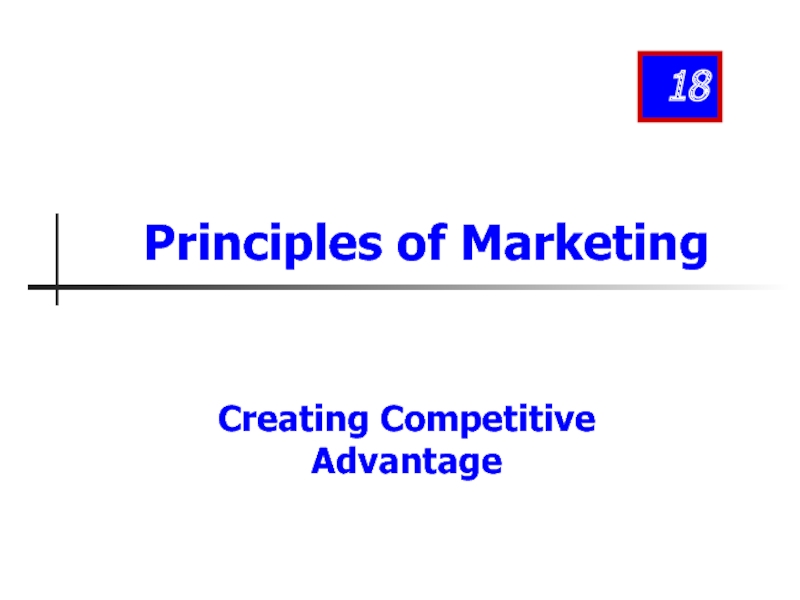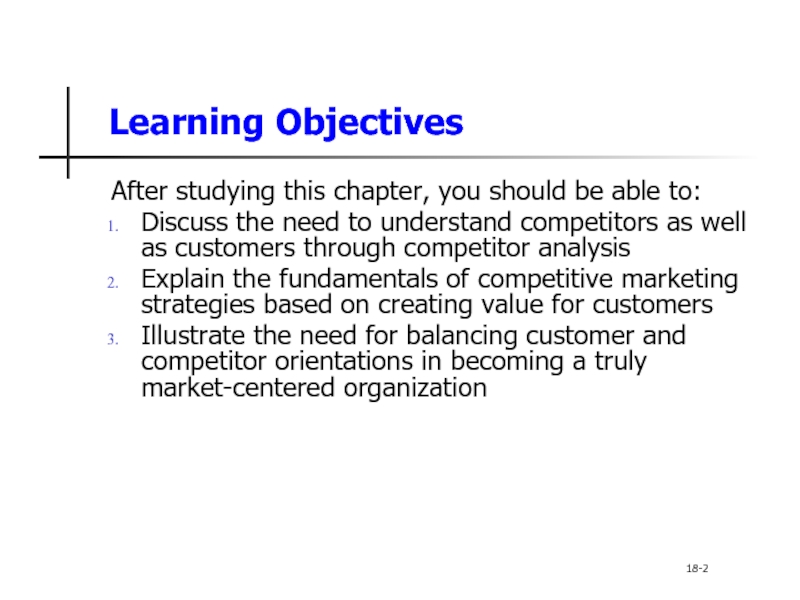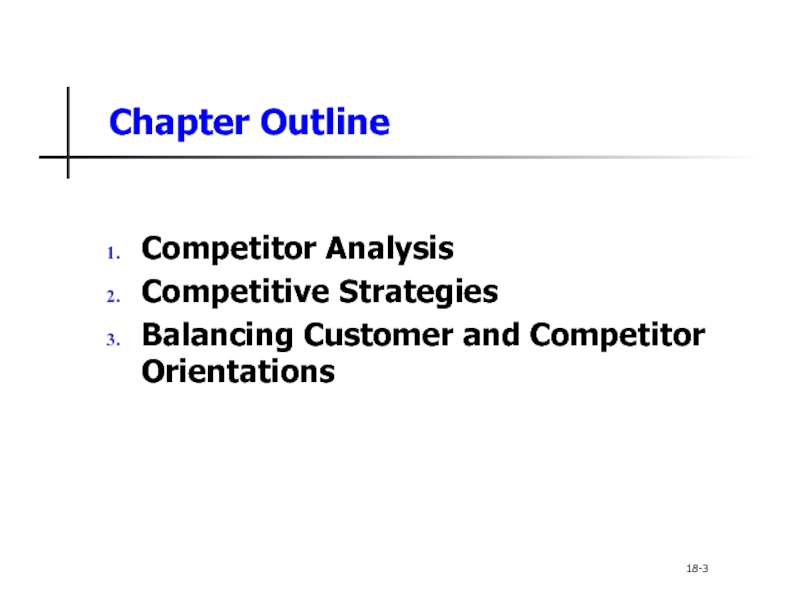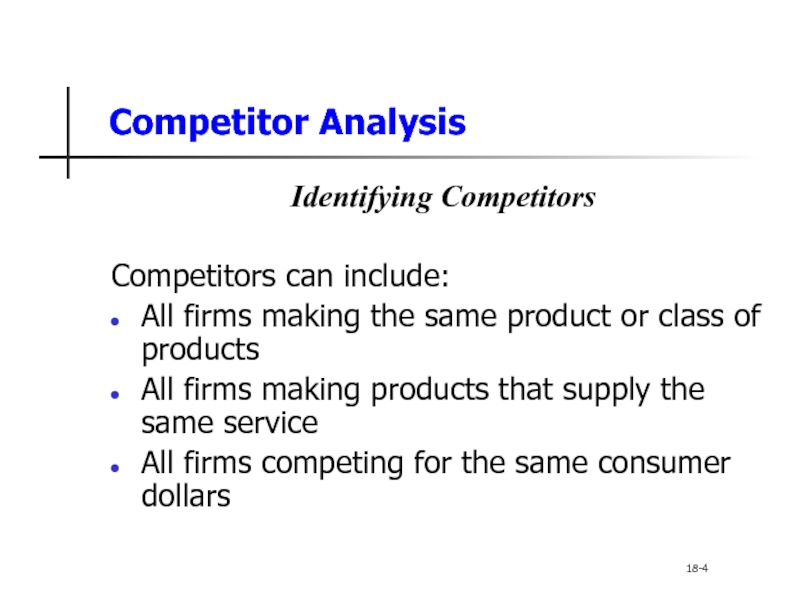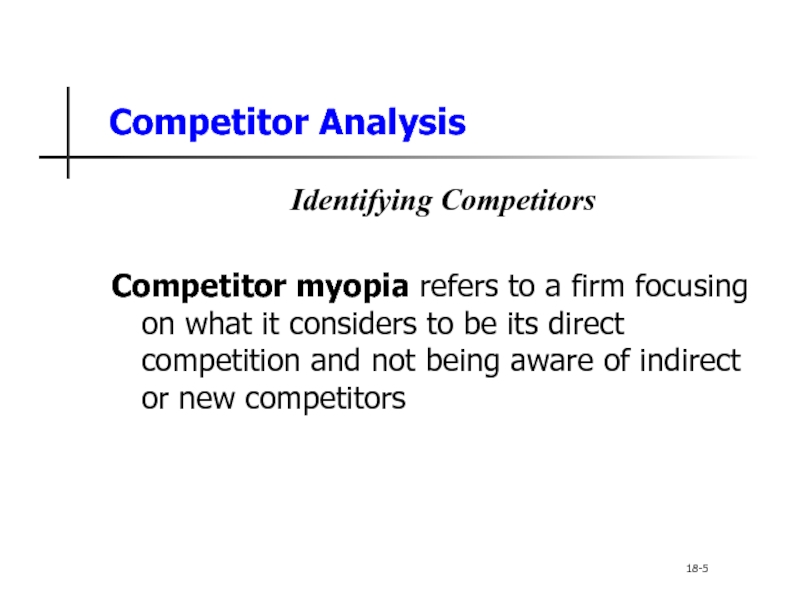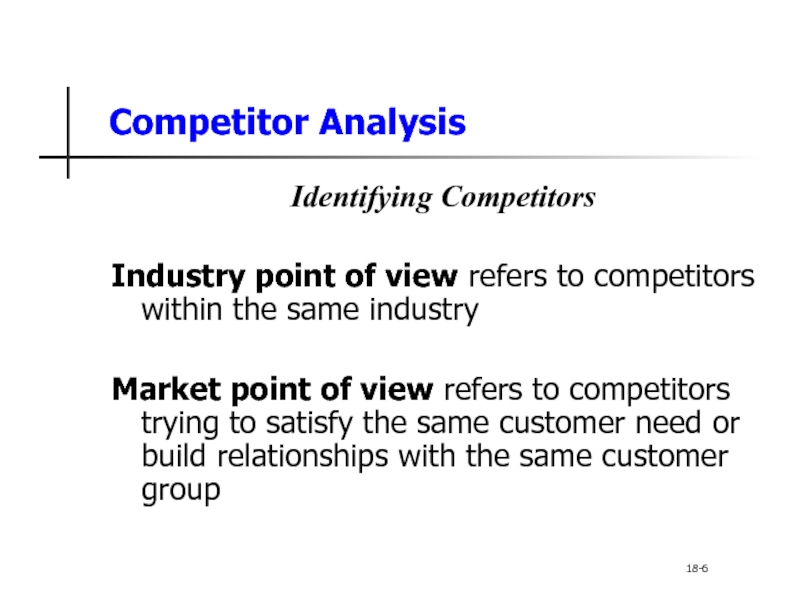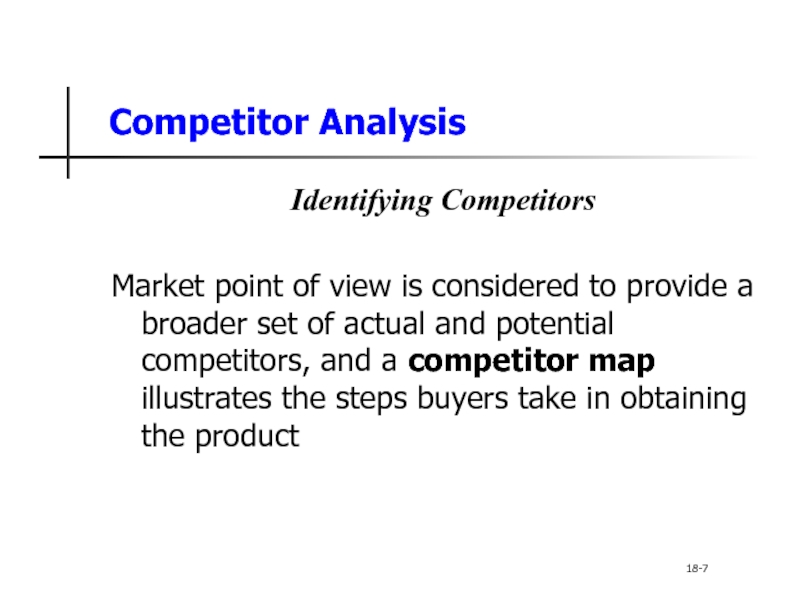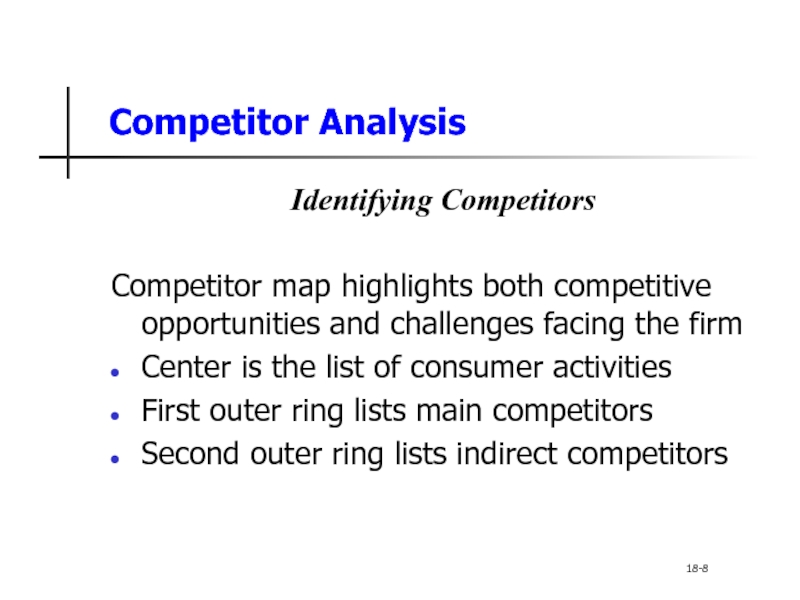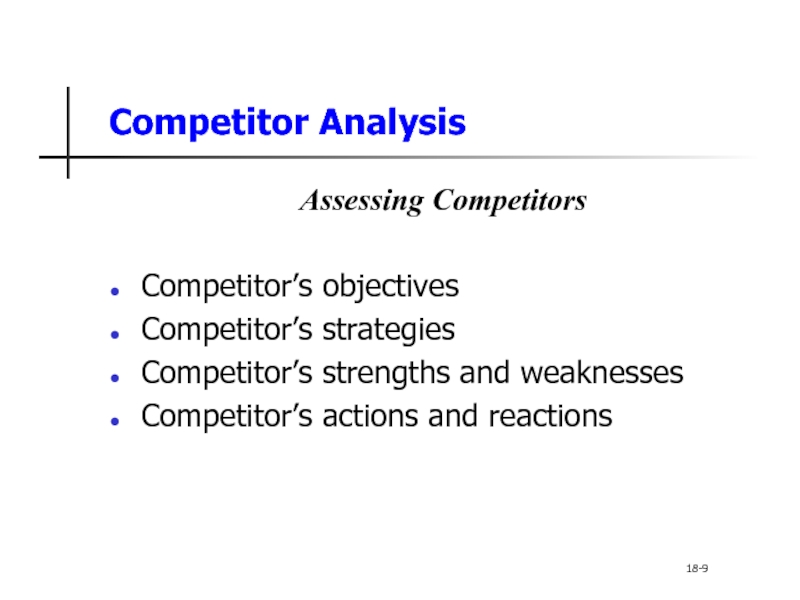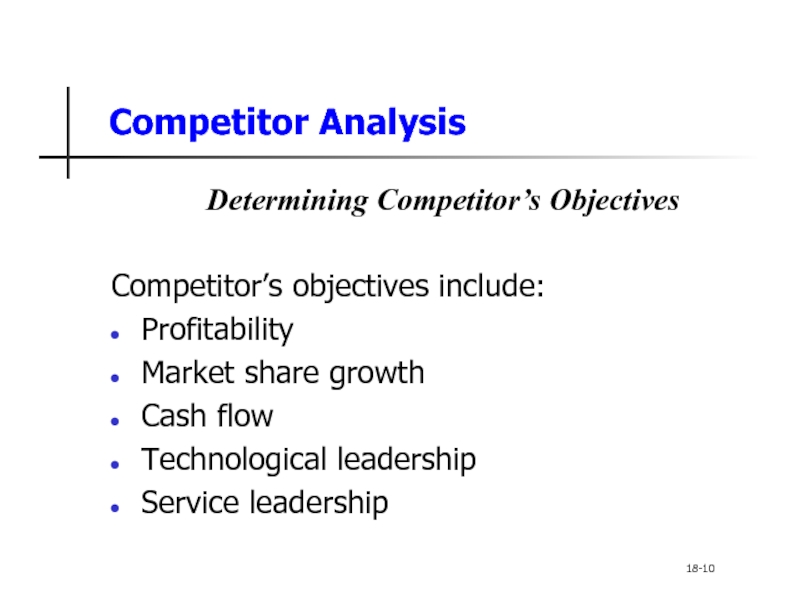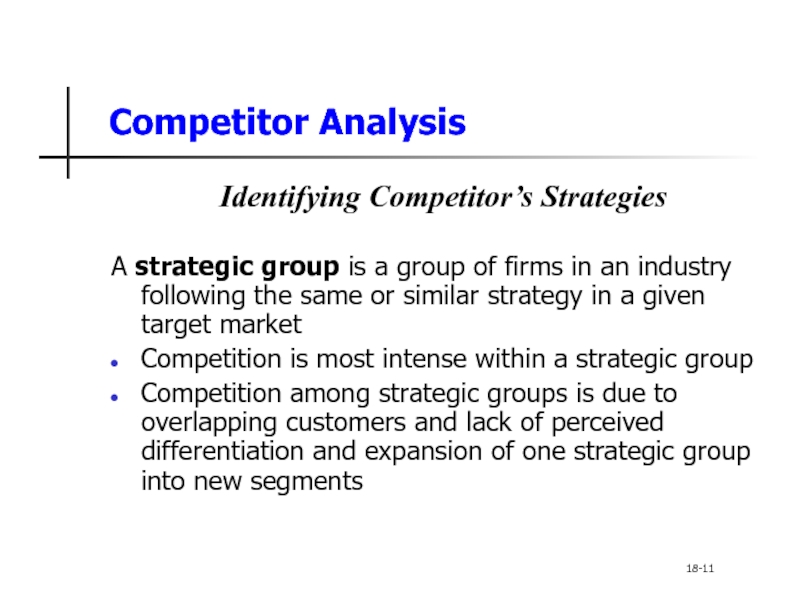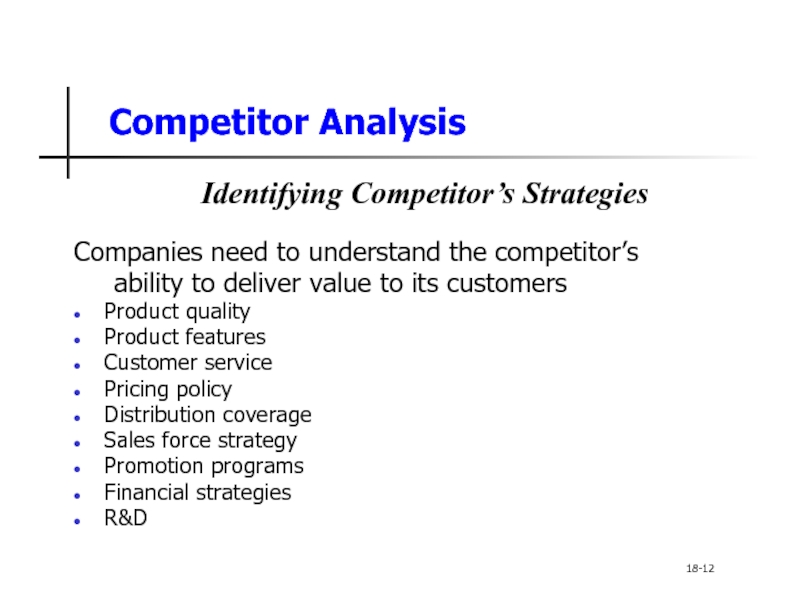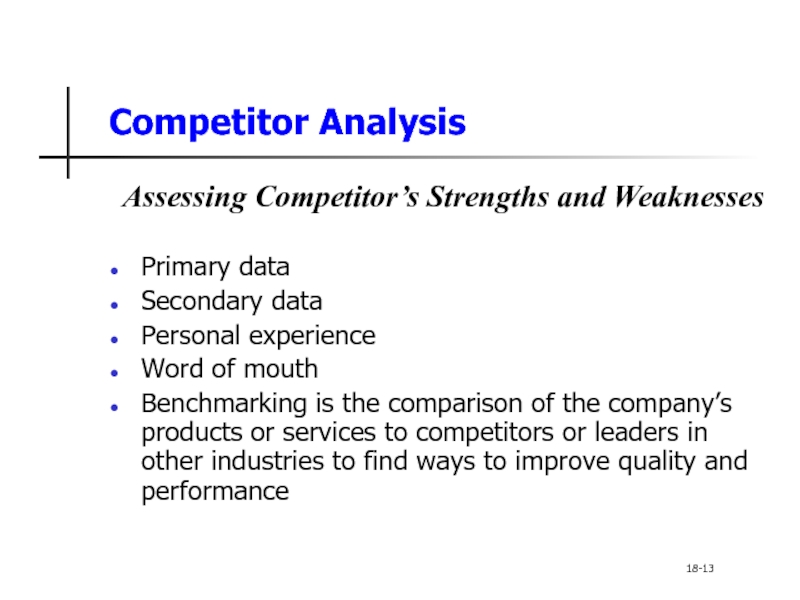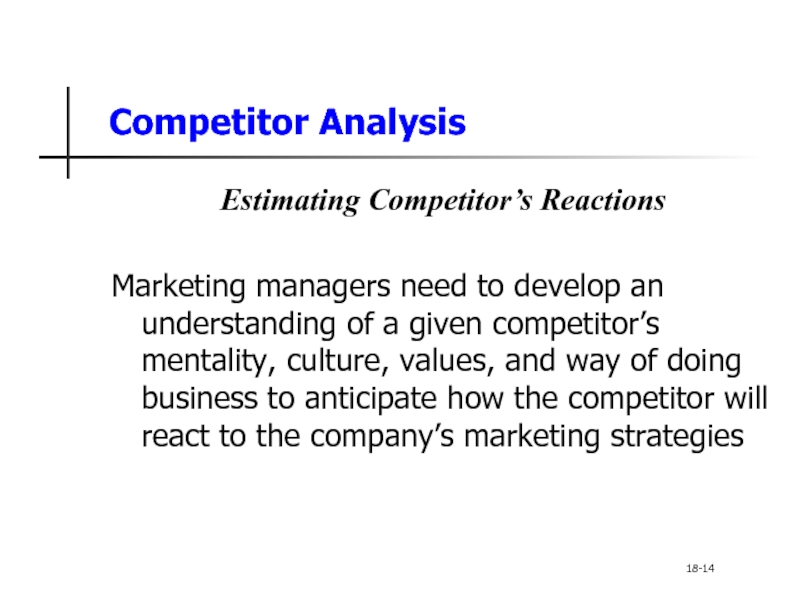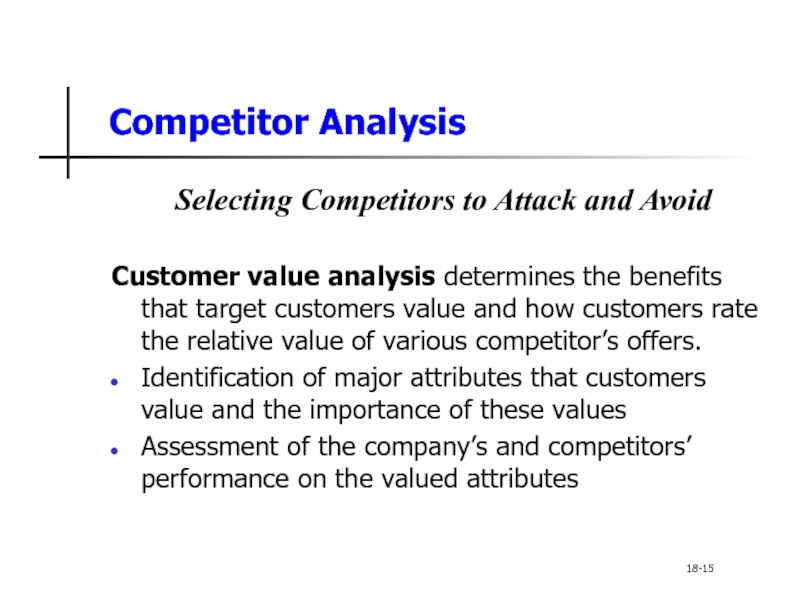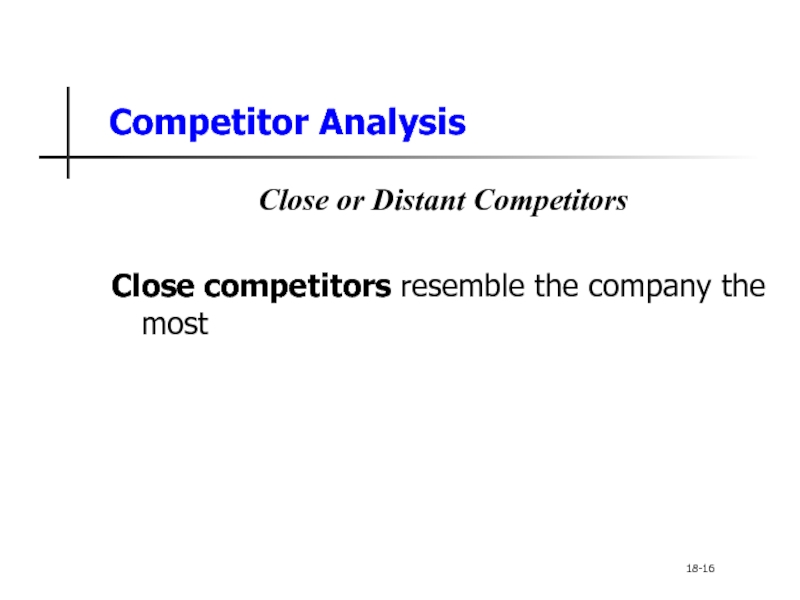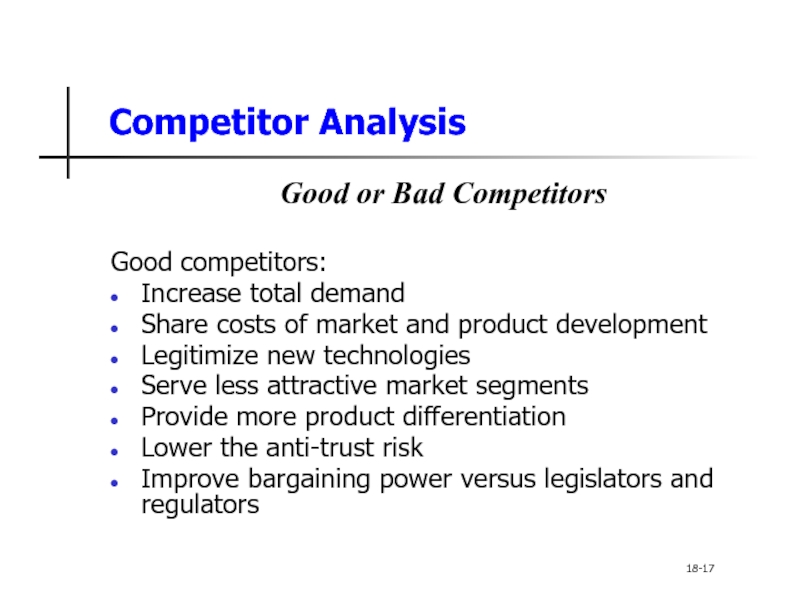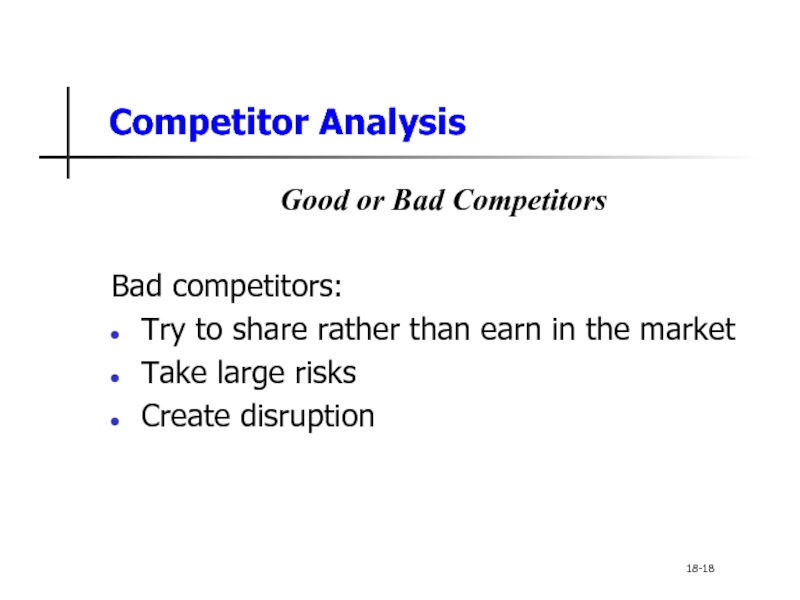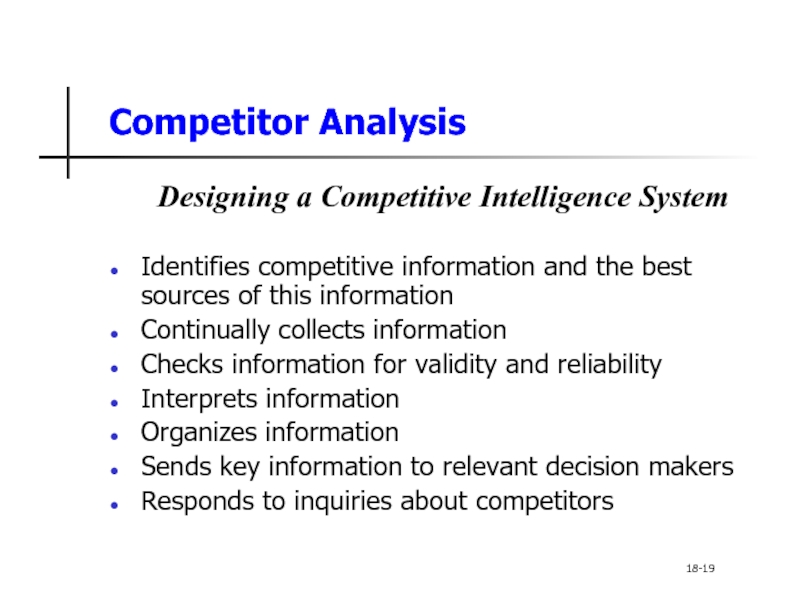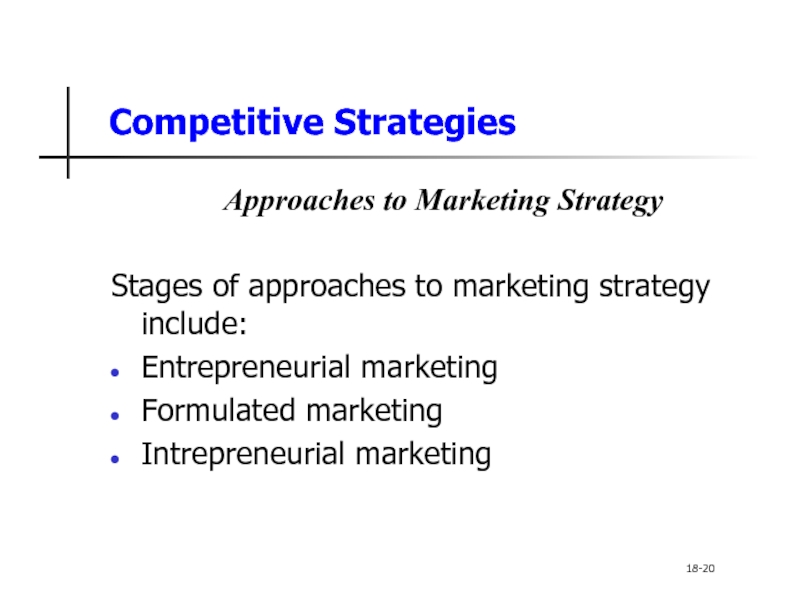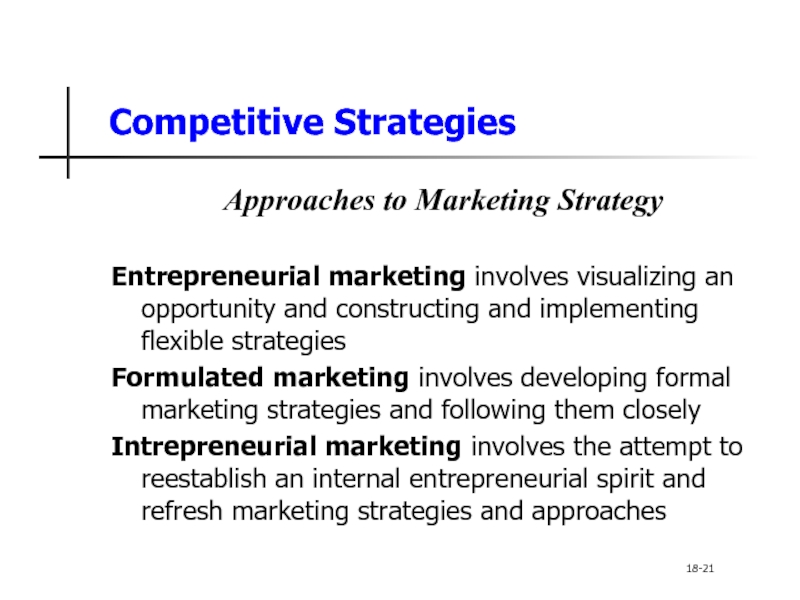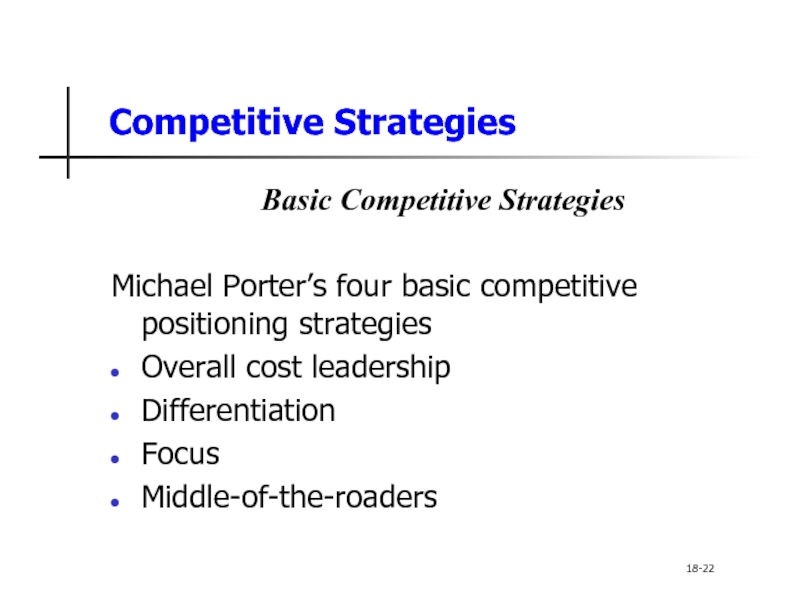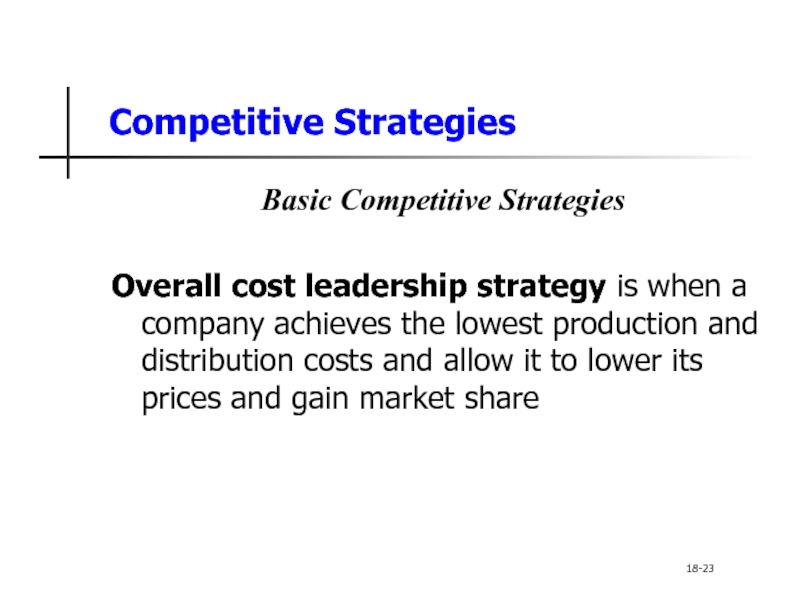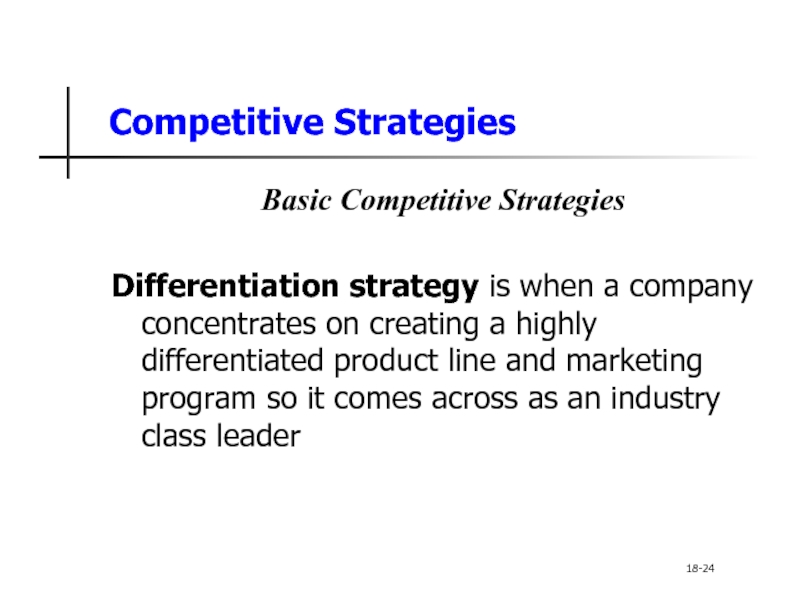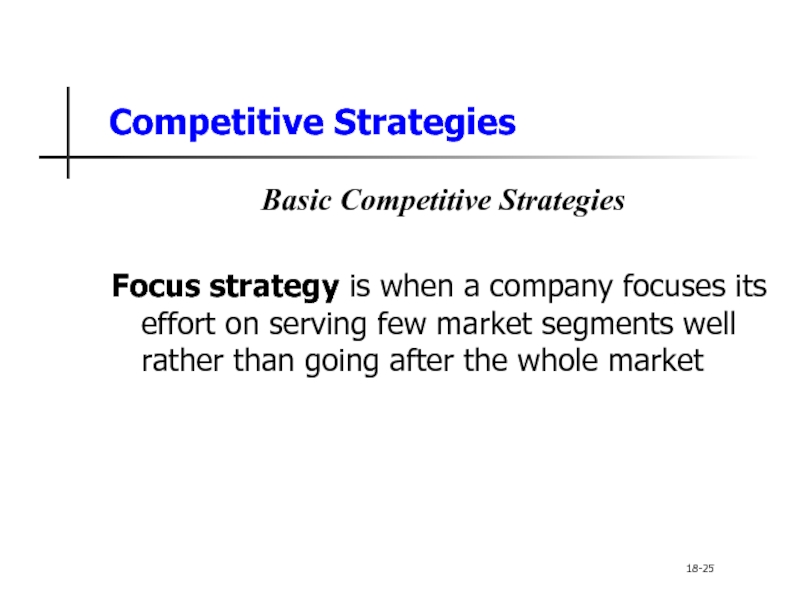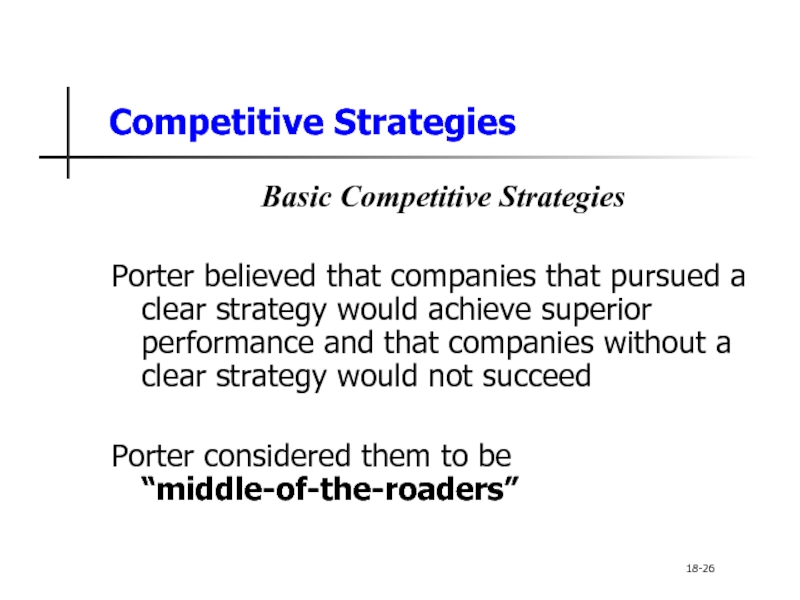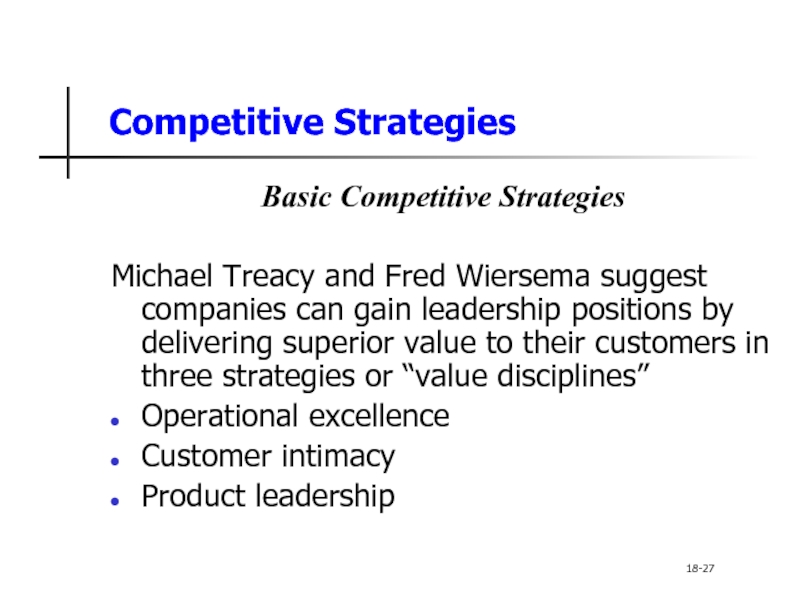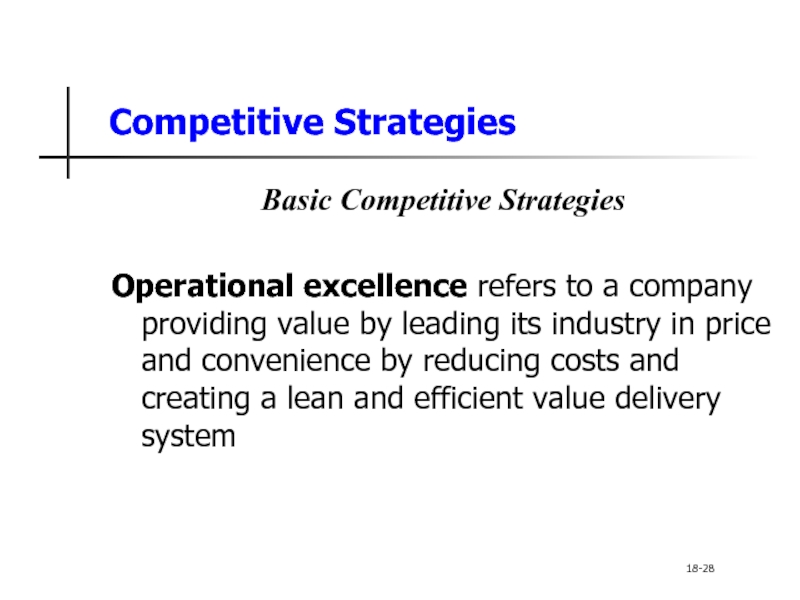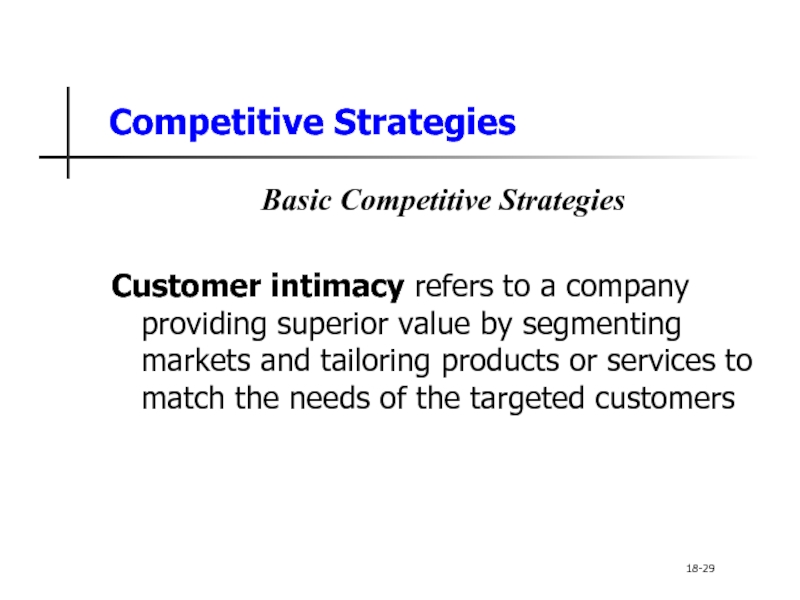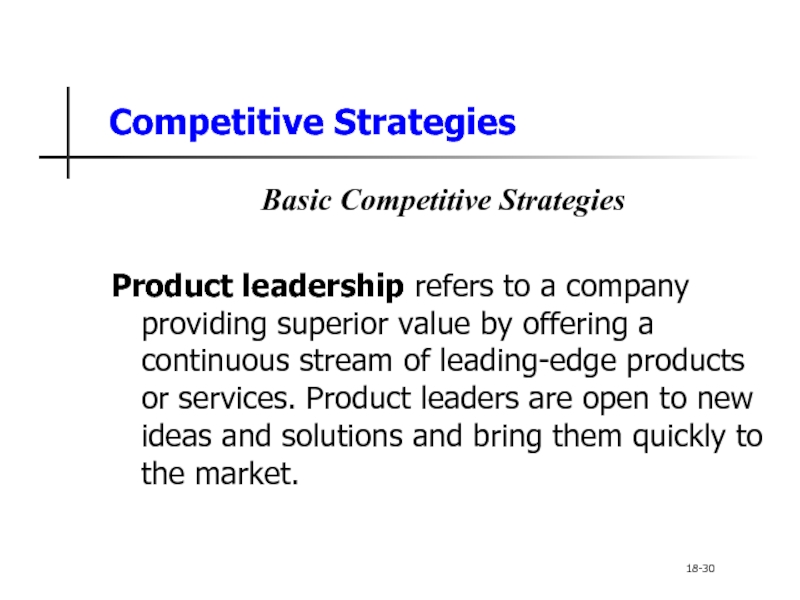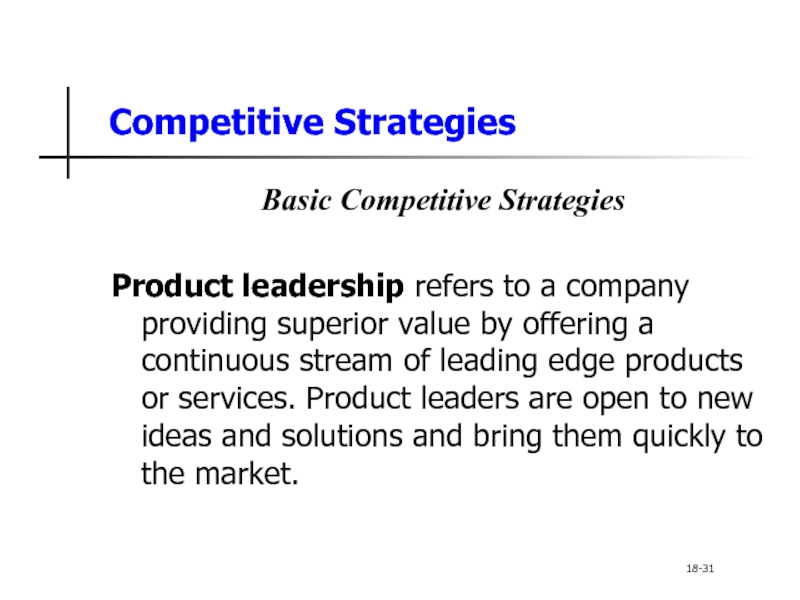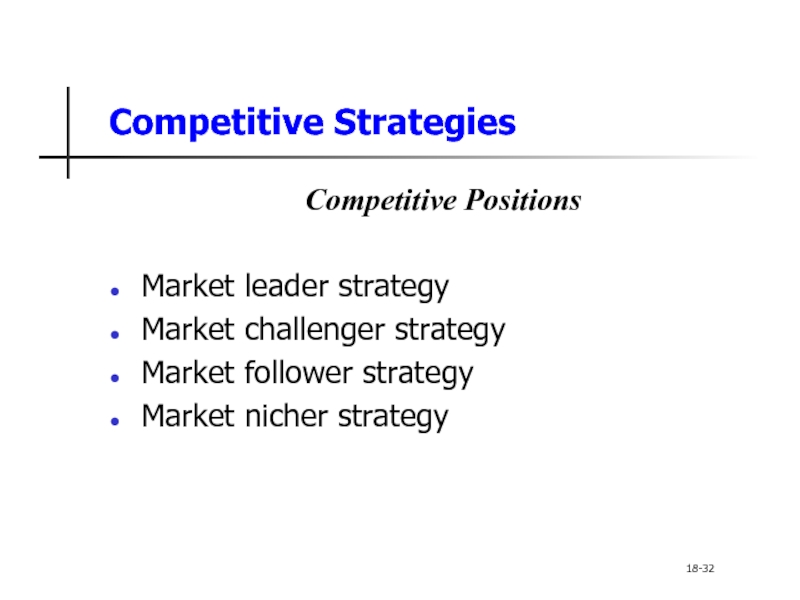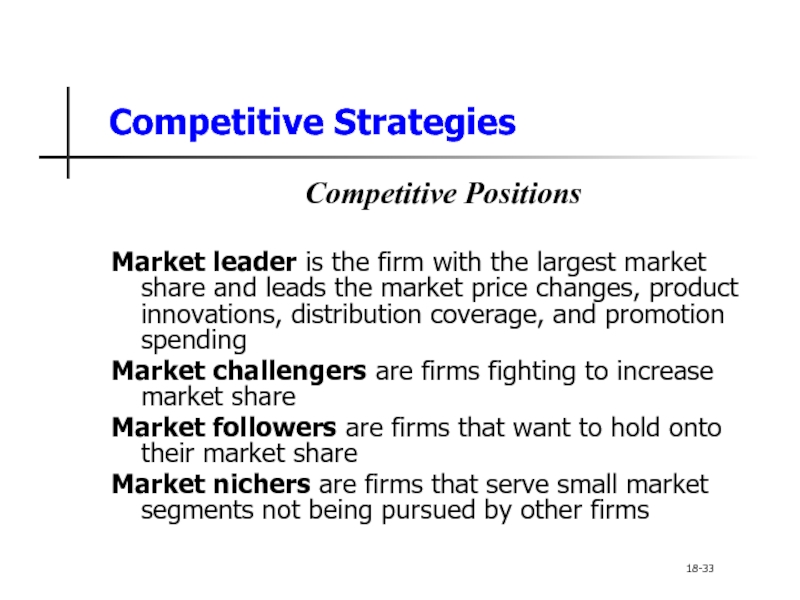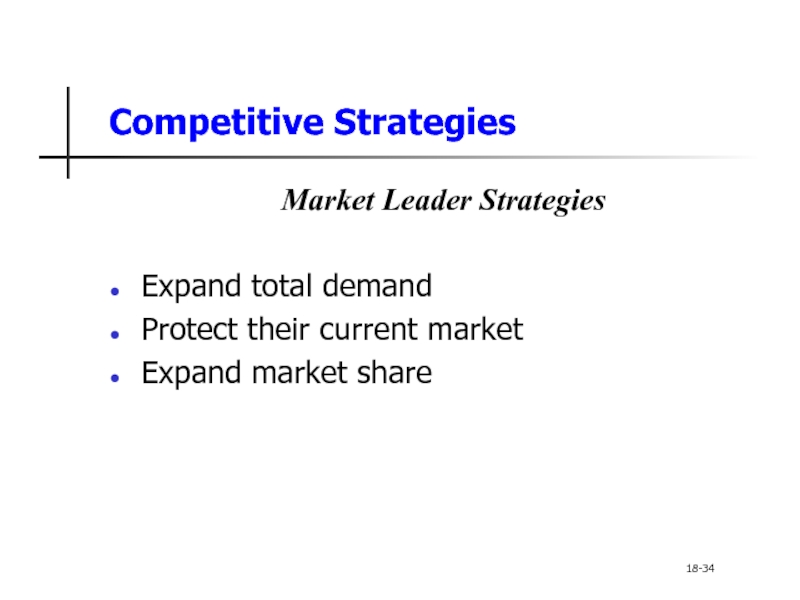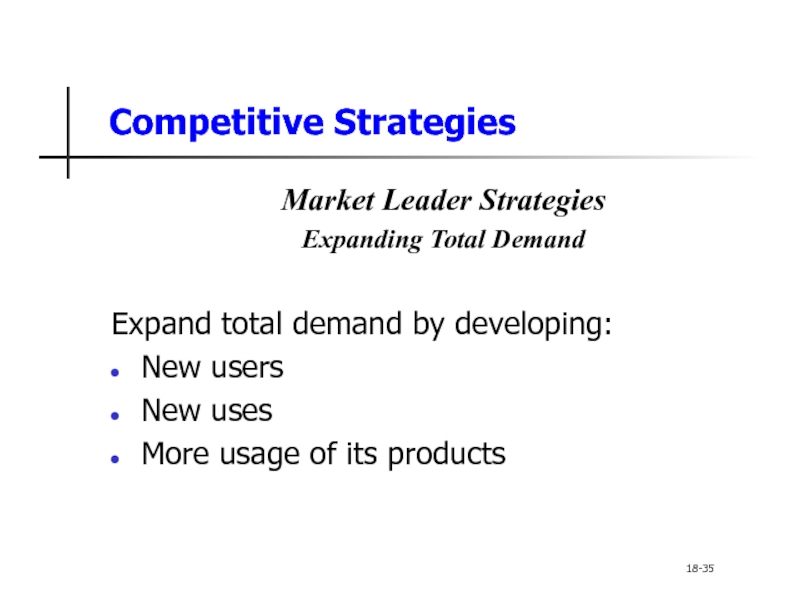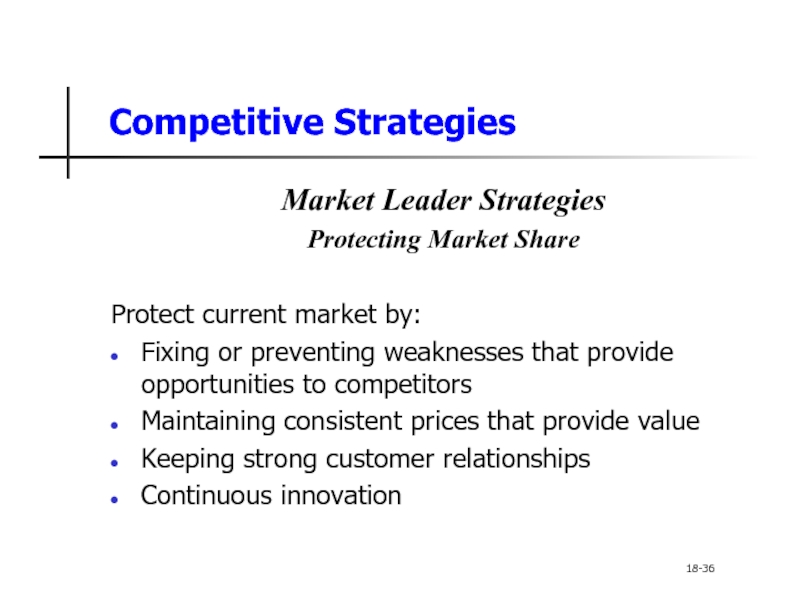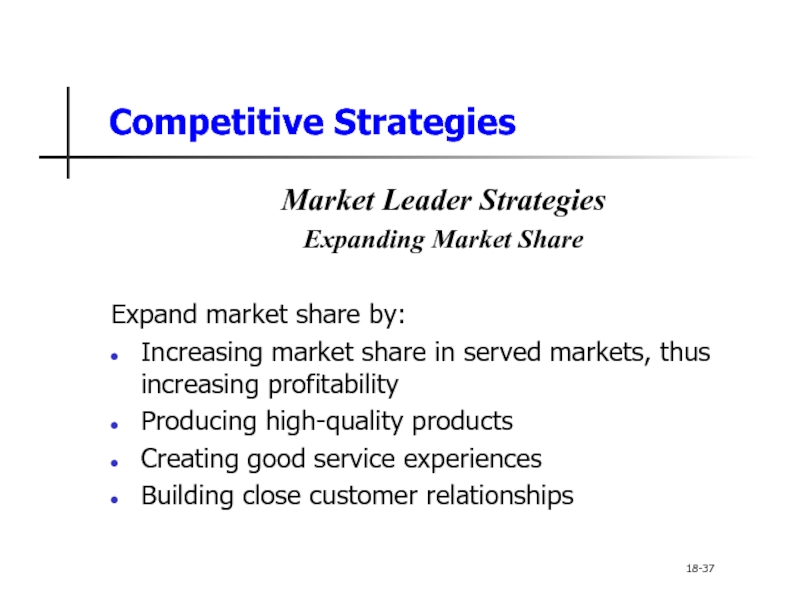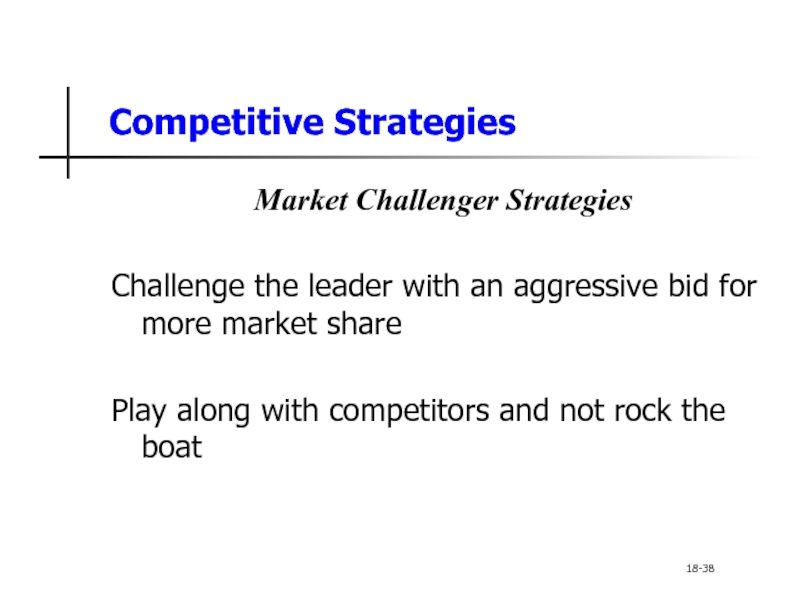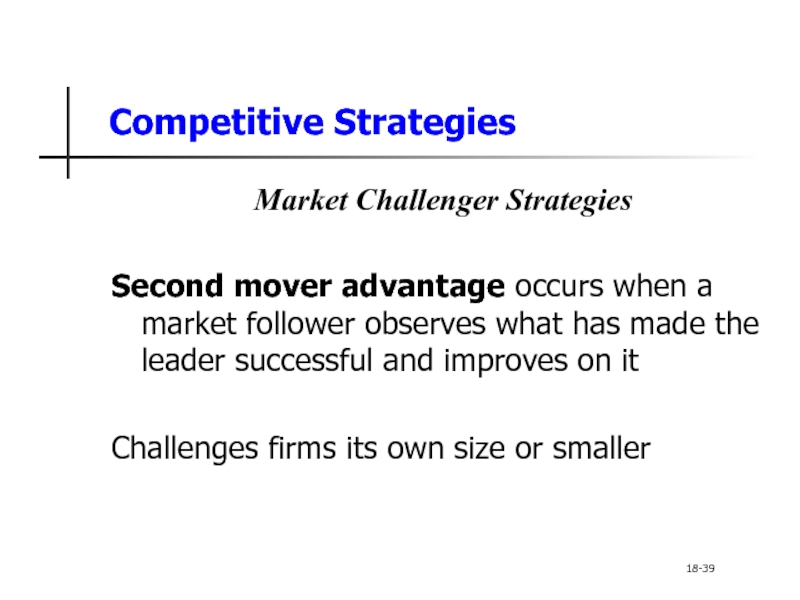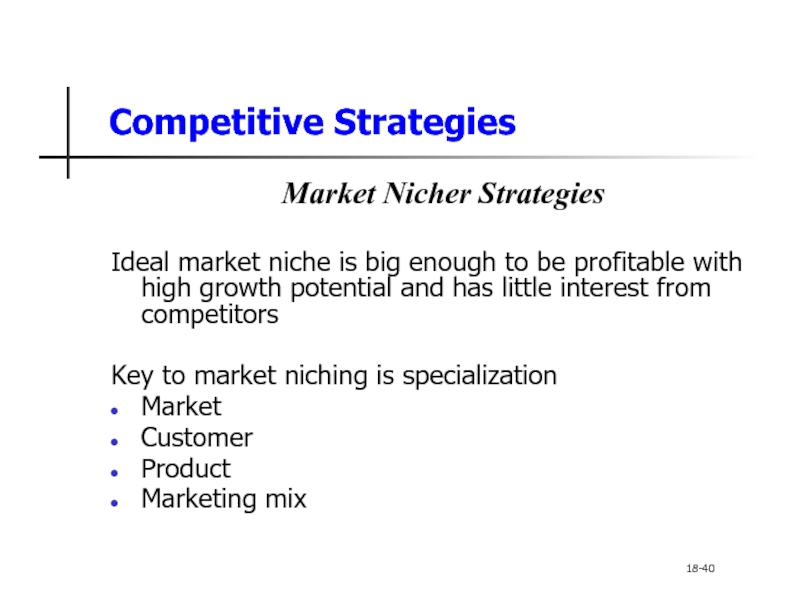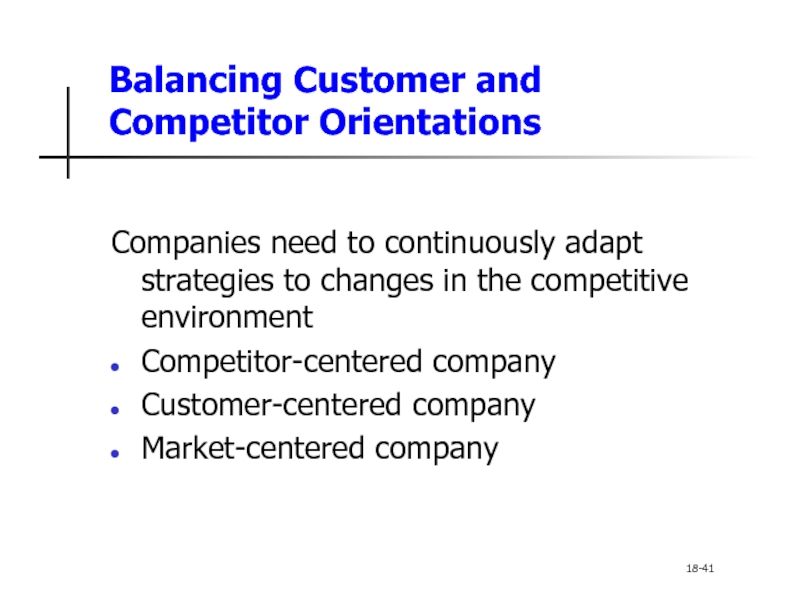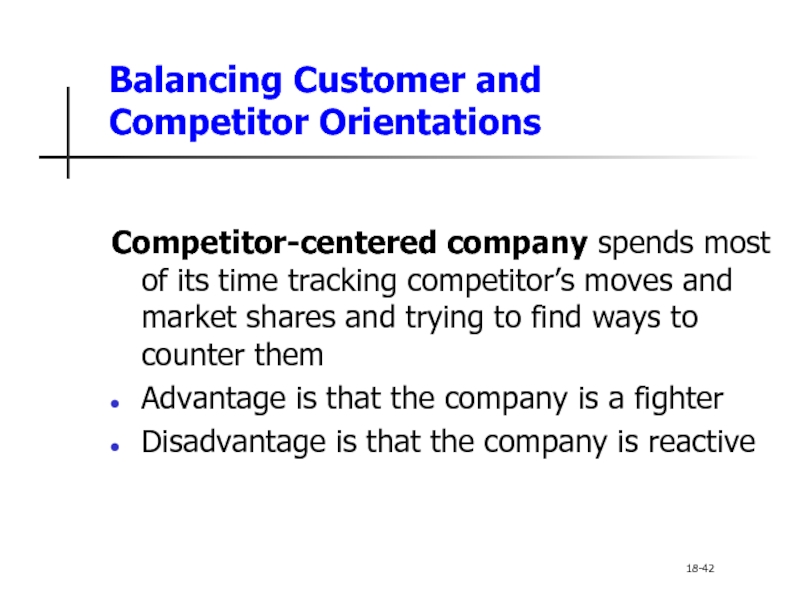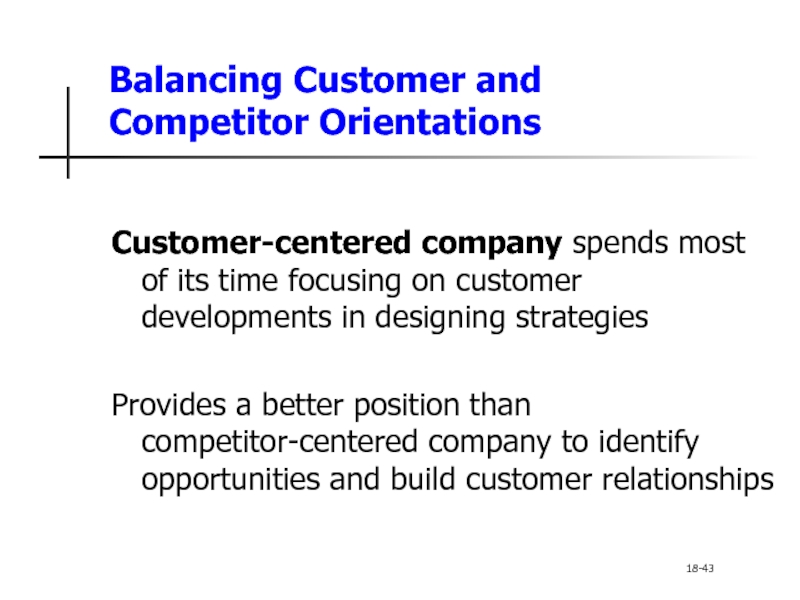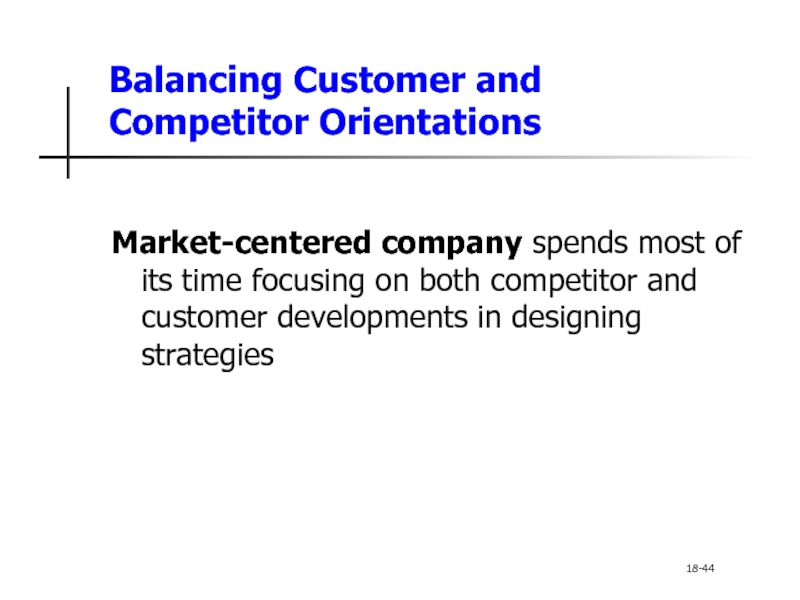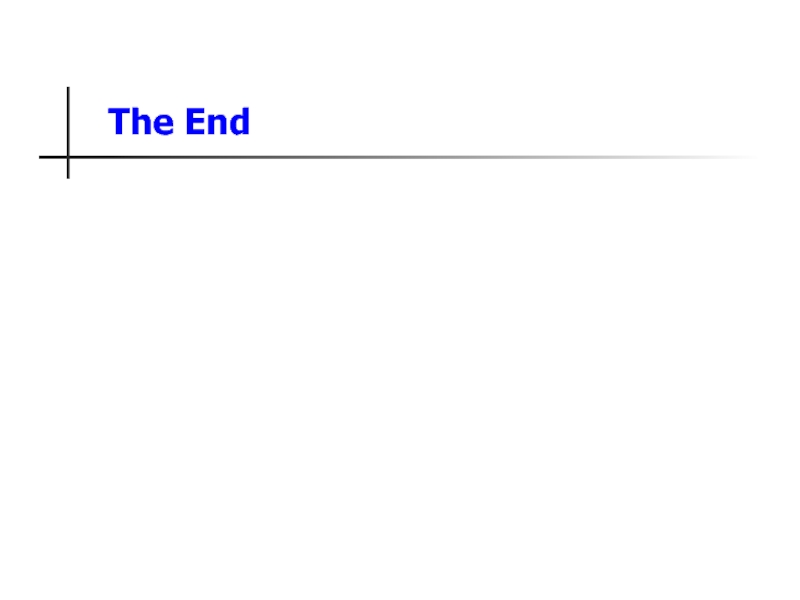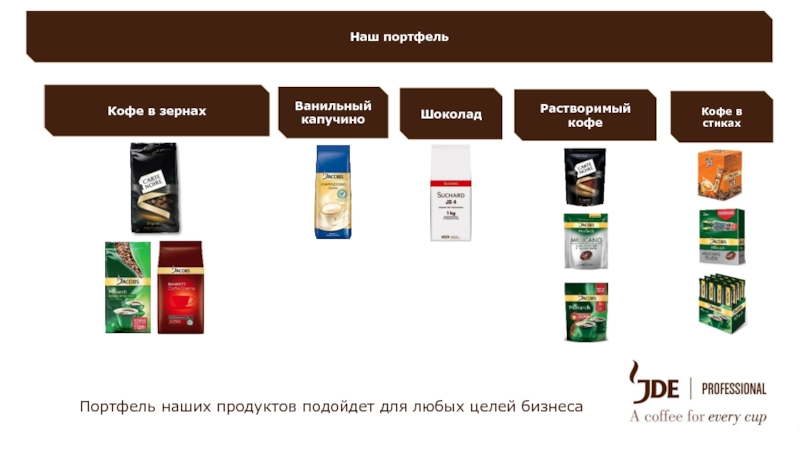- Главная
- Разное
- Дизайн
- Бизнес и предпринимательство
- Аналитика
- Образование
- Развлечения
- Красота и здоровье
- Финансы
- Государство
- Путешествия
- Спорт
- Недвижимость
- Армия
- Графика
- Культурология
- Еда и кулинария
- Лингвистика
- Английский язык
- Астрономия
- Алгебра
- Биология
- География
- Детские презентации
- Информатика
- История
- Литература
- Маркетинг
- Математика
- Медицина
- Менеджмент
- Музыка
- МХК
- Немецкий язык
- ОБЖ
- Обществознание
- Окружающий мир
- Педагогика
- Русский язык
- Технология
- Физика
- Философия
- Химия
- Шаблоны, картинки для презентаций
- Экология
- Экономика
- Юриспруденция
Principles of Marketing. Creating Competitive Advantage презентация
Содержание
- 1. Principles of Marketing. Creating Competitive Advantage
- 2. Learning Objectives After studying this chapter, you
- 3. Chapter Outline Competitor Analysis Competitive Strategies Balancing Customer and Competitor Orientations 18-3
- 4. Competitor Analysis Identifying Competitors Competitors
- 5. Competitor Analysis Identifying Competitors Competitor
- 6. Competitor Analysis Identifying Competitors Industry
- 7. Competitor Analysis Identifying Competitors Market point
- 8. Competitor Analysis Identifying Competitors Competitor map
- 9. Competitor Analysis Assessing Competitors Competitor’s
- 10. Competitor Analysis Determining Competitor’s Objectives
- 11. Competitor Analysis Identifying Competitor’s Strategies
- 12. Competitor Analysis Identifying Competitor’s Strategies
- 13. Competitor Analysis Assessing Competitor’s Strengths and Weaknesses
- 14. Competitor Analysis Estimating Competitor’s Reactions Marketing
- 15. Competitor Analysis Selecting Competitors to Attack
- 16. Competitor Analysis Close or Distant Competitors Close competitors resemble the company the most 18-16
- 17. Competitor Analysis Good or Bad Competitors
- 18. Competitor Analysis Good or Bad Competitors
- 19. Competitor Analysis Designing a Competitive Intelligence
- 20. Competitive Strategies Approaches to Marketing Strategy
- 21. Competitive Strategies Approaches to Marketing Strategy
- 22. Competitive Strategies Basic Competitive Strategies Michael
- 23. Competitive Strategies Basic Competitive Strategies
- 24. Competitive Strategies Basic Competitive Strategies
- 25. Competitive Strategies Basic Competitive Strategies
- 26. Competitive Strategies Basic Competitive Strategies
- 27. Competitive Strategies Basic Competitive Strategies
- 28. Competitive Strategies Basic Competitive Strategies
- 29. Competitive Strategies Basic Competitive Strategies Customer
- 30. Competitive Strategies Basic Competitive Strategies
- 31. Competitive Strategies Basic Competitive Strategies Product
- 32. Competitive Strategies Competitive Positions Market leader
- 33. Competitive Strategies Competitive Positions Market
- 34. Competitive Strategies Market Leader Strategies
- 35. Competitive Strategies Market Leader Strategies Expanding Total
- 36. Competitive Strategies Market Leader Strategies Protecting Market
- 37. Competitive Strategies Market Leader Strategies Expanding Market
- 38. Competitive Strategies Market Challenger Strategies
- 39. Competitive Strategies Market Challenger Strategies
- 40. Competitive Strategies Market Nicher Strategies
- 41. Balancing Customer and
- 42. Balancing Customer and
- 43. Balancing Customer and
- 44. Balancing Customer and
- 45. The End
Слайд 2Learning Objectives
After studying this chapter, you should be able to:
Discuss the
Explain the fundamentals of competitive marketing strategies based on creating value for customers
Illustrate the need for balancing customer and competitor orientations in becoming a truly market-centered organization
18-2
Слайд 3Chapter Outline
Competitor Analysis
Competitive Strategies
Balancing Customer and Competitor Orientations
18-3
Слайд 4
Competitor Analysis
Identifying Competitors
Competitors can include:
All firms making the same product or
All firms making products that supply the same service
All firms competing for the same consumer dollars
18-4
Слайд 5
Competitor Analysis
Identifying Competitors
Competitor myopia refers to a firm focusing on what
18-5
Слайд 6
Competitor Analysis
Identifying Competitors
Industry point of view refers to competitors within the
Market point of view refers to competitors trying to satisfy the same customer need or build relationships with the same customer group
18-6
Слайд 7Competitor Analysis
Identifying Competitors
Market point of view is considered to provide a
18-7
Слайд 8Competitor Analysis
Identifying Competitors
Competitor map highlights both competitive opportunities and challenges facing
Center is the list of consumer activities
First outer ring lists main competitors
Second outer ring lists indirect competitors
18-8
Слайд 9
Competitor Analysis
Assessing Competitors
Competitor’s objectives
Competitor’s strategies
Competitor’s strengths and weaknesses
Competitor’s actions and reactions
18-9
Слайд 10
Competitor Analysis
Determining Competitor’s Objectives
Competitor’s objectives include:
Profitability
Market share growth
Cash flow
Technological leadership
Service leadership
18-10
Слайд 11
Competitor Analysis
Identifying Competitor’s Strategies
A strategic group is a group of firms
Competition is most intense within a strategic group
Competition among strategic groups is due to overlapping customers and lack of perceived differentiation and expansion of one strategic group into new segments
18-11
Слайд 12
Competitor Analysis
Identifying Competitor’s Strategies
Companies need to understand the competitor’s
ability to deliver
Product quality
Product features
Customer service
Pricing policy
Distribution coverage
Sales force strategy
Promotion programs
Financial strategies
R&D
18-12
Слайд 13Competitor Analysis
Assessing Competitor’s Strengths and Weaknesses
Primary data
Secondary data
Personal experience
Word of mouth
Benchmarking
18-13
Слайд 14Competitor Analysis
Estimating Competitor’s Reactions
Marketing managers need to develop an understanding of
18-14
Слайд 15
Competitor Analysis
Selecting Competitors to Attack and Avoid
Customer value analysis determines the
Identification of major attributes that customers value and the importance of these values
Assessment of the company’s and competitors’ performance on the valued attributes
18-15
Слайд 16Competitor Analysis
Close or Distant Competitors
Close competitors resemble the company the most
18-16
Слайд 17Competitor Analysis
Good or Bad Competitors
Good competitors:
Increase total demand
Share costs of market
Legitimize new technologies
Serve less attractive market segments
Provide more product differentiation
Lower the anti-trust risk
Improve bargaining power versus legislators and regulators
18-17
Слайд 18Competitor Analysis
Good or Bad Competitors
Bad competitors:
Try to share rather than earn
Take large risks
Create disruption
18-18
Слайд 19
Competitor Analysis
Designing a Competitive Intelligence System
Identifies competitive information and the best
Continually collects information
Checks information for validity and reliability
Interprets information
Organizes information
Sends key information to relevant decision makers
Responds to inquiries about competitors
18-19
Слайд 20Competitive Strategies
Approaches to Marketing Strategy
Stages of approaches to marketing strategy include:
Entrepreneurial
Formulated marketing
Intrepreneurial marketing
18-20
Слайд 21Competitive Strategies
Approaches to Marketing Strategy
Entrepreneurial marketing involves visualizing an opportunity and
Formulated marketing involves developing formal marketing strategies and following them closely
Intrepreneurial marketing involves the attempt to reestablish an internal entrepreneurial spirit and refresh marketing strategies and approaches
18-21
Слайд 22Competitive Strategies
Basic Competitive Strategies
Michael Porter’s four basic competitive positioning strategies
Overall cost
Differentiation
Focus
Middle-of-the-roaders
18-22
Слайд 23
Competitive Strategies
Basic Competitive Strategies
Overall cost leadership strategy is when a company
18-23
Слайд 24
Competitive Strategies
Basic Competitive Strategies
Differentiation strategy is when a company concentrates on
18-24
Слайд 25
Competitive Strategies
Basic Competitive Strategies
Focus strategy is when a company focuses its
18-25
Слайд 26
Competitive Strategies
Basic Competitive Strategies
Porter believed that companies that pursued a clear
Porter considered them to be “middle-of-the-roaders”
18-26
Слайд 27
Competitive Strategies
Basic Competitive Strategies
Michael Treacy and Fred Wiersema suggest companies can
Operational excellence
Customer intimacy
Product leadership
18-27
Слайд 28
Competitive Strategies
Basic Competitive Strategies
Operational excellence refers to a company providing value
18-28
Слайд 29Competitive Strategies
Basic Competitive Strategies
Customer intimacy refers to a company providing superior
18-29
Слайд 30
Competitive Strategies
Basic Competitive Strategies
Product leadership refers to a company providing superior
18-30
Слайд 31Competitive Strategies
Basic Competitive Strategies
Product leadership refers to a company providing superior
18-31
Слайд 32Competitive Strategies
Competitive Positions
Market leader strategy
Market challenger strategy
Market follower strategy
Market nicher strategy
18-32
Слайд 33
Competitive Strategies
Competitive Positions
Market leader is the firm with the largest market
Market challengers are firms fighting to increase market share
Market followers are firms that want to hold onto their market share
Market nichers are firms that serve small market segments not being pursued by other firms
18-33
Слайд 34
Competitive Strategies
Market Leader Strategies
Expand total demand
Protect their current market
Expand market share
18-34
Слайд 35Competitive Strategies
Market Leader Strategies
Expanding Total Demand
Expand total demand by developing:
New users
New
More usage of its products
18-35
Слайд 36Competitive Strategies
Market Leader Strategies
Protecting Market Share
Protect current market by:
Fixing or preventing
Maintaining consistent prices that provide value
Keeping strong customer relationships
Continuous innovation
18-36
Слайд 37Competitive Strategies
Market Leader Strategies
Expanding Market Share
Expand market share by:
Increasing market share
Producing high-quality products
Creating good service experiences
Building close customer relationships
18-37
Слайд 38
Competitive Strategies
Market Challenger Strategies
Challenge the leader with an aggressive bid for
Play along with competitors and not rock the boat
18-38
Слайд 39
Competitive Strategies
Market Challenger Strategies
Second mover advantage occurs when a market follower
Challenges firms its own size or smaller
18-39
Слайд 40
Competitive Strategies
Market Nicher Strategies
Ideal market niche is big enough to be
Key to market niching is specialization
Market
Customer
Product
Marketing mix
18-40
Слайд 41
Balancing Customer and Competitor Orientations
Companies
Competitor-centered company
Customer-centered company
Market-centered company
18-41
Слайд 42Balancing Customer and Competitor Orientations
Competitor-centered
Advantage is that the company is a fighter
Disadvantage is that the company is reactive
18-42
Слайд 43Balancing Customer and Competitor Orientations
Customer-centered
Provides a better position than competitor-centered company to identify opportunities and build customer relationships
18-43
Слайд 44
Balancing Customer and Competitor Orientations
Market-centered
18-44
